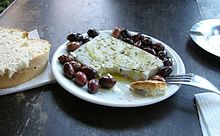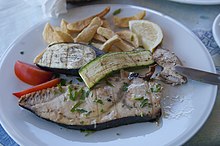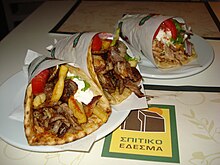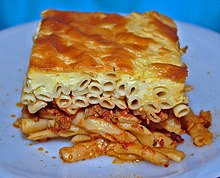En particulier alimentaires, y compris repas préparés surgelés, produits surgelés à base de pommes de terre et produits de la mer, par exemple 1- Le yaourt grec 2- Le miel 3- Le Mastic (résine de couleur ivoire) provient de l'île de Chios, de la mer Égée 4-
Une grande variété de fromages est utilisée dans la cuisine grecque, tels que la Feta, le Kasséri, le Kefalotýri, la Graviera, l’Anthótyro, le Manoúri, la Metsovone et la Mizithra.
5- Le souvláki
Si vous osez un voyage en Grèce, et que vous la traversez de bout en bout, vous serez impressionné par la variété des produits traditionnels spéciaux que vous découvrirez. Les meilleurs produits et les plus uniques ont été distingués en portant la mention A.O.P qui signifie produits d’appellation d’origine protégée (en grec Π.Ο.Π). Il s’agit d’une liste continuellement enrichie qui conserve en même temps des normes très élevées.
Parmi ces délicieux produits grecs, nous pouvons distinguer non seulement les régions productives mais également les producteurs de marque, qui prennent soin de la terre qui les a mis au monde. N’hésitez pas à partir à la recherche de chacun d’entre eux pour noter l’influence de sa région, son authenticité et son identité unique.
Les principaux produits traditionnels de la Grèce
L’huile d’olive grecque
Le “trésor” de l'alimentation grecque. Elle constitue la base de
la cuisine grecque et enrichit avec du goût votre table. De la bonne huile grecque mais aussi de l'huile d'olive verte à partir d'olives fraîches, un jus vert doré, extrait de l’arbre-symbole séculaire et met en valeur toutes les saveurs.
Toute la Grèce est remplie d’oliviers, l’arbre symbole qui fournit un produit en or. De la Crète, dans les villages de la Canée et d’Héraklion, jusqu’au Péloponnèse, en Laconie, en Argolide et à Kalamata, une huile d’olive A.O.P résultant de différentes espèces d’olives avec des caractéristiques différentes.
Les olives de table de Kalamos, d’Amfissa, d’Arta sont également classées A.O.P tout comme les conserves d’olives de Roviès et de Stylida, les olives de Thassos, de Chios, de Rethymnon, celles provenant du mont Pélion et de la Chalcidique, les olives proposées en mézè pour accompagner un ouzo ou un tsipouro ou une soupe de légumes secs et des salades.
Poissons et fruits de mer frais
Au sommet, les sources musicales des montagnes, l’eau qui forme des fleuves rapides et des lacs calmes qui se déversent dans la mer, entraînant ainsi tous les précieux ingrédients du sol fertile grec. Cette eau remplit les creux des mers Égée et Ionienne et constitue l’environnement naturel idéal qui englobe un trésor maritime légendaire. Dans les bras de l’archipel, des récifs et des petits golfes se cachent aux alentours des îles, lesquels constituent des lieux uniques qui regorgent de bancs de grands et de petits poissons ainsi que de fruits de mer.
Ils sont pêchés par des groupes de pêcheurs et appartiennent aux produits grecs par excellence méritant la dégustation lors de vos vacances en Grèce. La production est de petite envergure, à l’image de la taille de la mer. Le goût est condensé et limpide comme l’eau. Il en va de même pour les animaux qui grandissent dans leur environnement naturel, dans des fermes de petite ou de moyenne taille ou librement dans les montagnes. Ici vous goûterez les matières premières, non industrialisées.
Morceaux de fromage grec à la Crémerie Pappas
Les viandes grecques
Vous mangerez de la viande de qualité exceptionnelle, de la viande d’agneaux et de chèvres vivant librement dans les pâturages du mont Iti, dans les plaines d’Étolie-Acarnanie, dans les montagnes de l’Épire ou qui gambadent sur les rochers isolés le long de la ligne côtière crétoise. Vous goûterez l’excellent veau grec, bien nourri, dont la viande est tendre, des buffles qui grandissent dans de petites fermes en Macédoine et en Thessalie, des poulets frais et des poulardes qui picorent toute l’année, des porcs qui produisent une chair tendre et le porc noir hellénique, menacé d’extinction, dont le goût est incomparable. Si vous vous trouvez en Grèce Centrale, essayez l’agneau et le chevrot d’Elassona - célèbres pour leur délicieuse viande tendre, protégée et bien élévée.

Les fromages grecsUne place spéciale parmi les produits grecs traditionnels occupent également les produits laitiers. La Grèce produit des produits laitiers un peu partout sur son territoire. Hormis les excellents fromages à base de lait de brebis comme la féta et la graviéra, il existe d’autres fromages frais faciles à étaler tel le kasséri, qui est à base de beurre. Les xinotiria (fromages secs) sont également délicieux. De Xanthi au sud de la Crète et des Cyclades aux îles Ioniennes ou en Épire, les fromages grecs, présents à chaque repas, constituent de vrais petits bijoux qui agrémentent presque tous les plats et vous attendent à les découvrir.
Comparez le goût de la gravièra de Naxos à celle de la Crète, mais aussi à celle d’Agrafa, des régions qui peuvent être fières de leur production fromagère. Un fromage A.O.P est le fromage frais d’Anevato à Grévéna, la kopanisti au poivre et le ladotiri de Lesvos. Cherchez chez les traiteurs traditionnels, que vous trouverez dans toutes les villes, le manouri, un fromage particulier, le fromage fumé de Metsovo appelé Metsovone, le baggio provenant du continent.
Le pichtogalo et la xinomizythra de la Canée, des fromages à base de lait de brebis, constituent des modèles uniques d’une fromagerie particulièrement intéressante, le kalathaki de Limnos est considéré comme la féta insulaire, le fromage San Michali de Syros peut être comparé au parmesan, la sfela de Laconie, la singulière formaela d’Arachova, le katiki crémeux de Domokos et bien sûr la féta au lait de brebis, vieillie, molle ou dure, le fromage qui ne manque sur aucune table grecque.
Le pain
Un bon morceau de pain sera toujours présent sur la table, produit de blés solides et puissants et cuit dans des fours à bois. Ce que vous souhaitez manger est sans importance, la présence du pain sur la table, à tous les repas, est une condition sine qua non. Il est tout aussi bon seul: versez sur le pain chaud quelques goutes d’huile d’olive et un peu de gros sel marin.
Produits delicatessen La liste des produits traditionnels grecs n’exclut pas les produits delicatessen exclusifs comme la poutargue du Messolonghi pour les palais sélectifs, le miel blanc d’Elati que les abeilles produisent grâce au miellat du pin dans des conditions idéales, le crocus de Kozani, le safran grec qui est récolté à la main dans les champs de Kozani.
Chios, grâce à son microclimat exceptionnel, produit le mastic A.O.P, un produit unique au monde qui se retrouve dans une gamme exceptionnelle de produits de qualité supérieure que nous retrouvons partout au monde.
Goûtez les produits traditionnels succulents qui reflètent le travail de leur producteur et qui ont une saveur qui retrace l’histoire de leur région.
Fruits et légumes
Les fruits et les légumes qui adoptent le caractère du sol fertile sont innombrables, comme les pommes rouge de Zagora au Mont Pélion mais aussi la petite pomme appelé firiki, les pommes rares de Tripoli appelées pommes delicious-pilafa, les cerises croquantes de Rodochori à Naoussa et les pèches juteuses, l’aubergine ferme de Leonidio, les figues séchées de Kimi, les oranges juteuses de Maleme, près de la Canée.
De plus, les raisins secs de Zante et de Corinthe mondialement connus, les kiwis grecs de Sperchios, les célèbres pistaches d’Egine et de Fthiotida et bien évidemment la fava, douce et dorée, de Santorin. Les éleveurs expérimentés de la Grèce continentale peuvent être fiers de leurs agneaux ainsi que des chevreaux d’Elassona, protégés également, élevés dans les règles de l’art et dont la chair est tendrement délicieuse.
Emportez un goût des produits locaux traditionnels, qui constituent les ambassadeurs de la culture culinaire grecque à l'étranger. Découvrez le jeu de la nature dans tous les produits grecs.





































